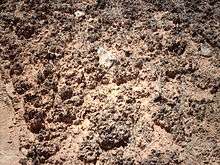Hovenweep National Monument
Hovenweep National Monument straddles the border between Southwestern Colorado and Utah's Canyon Country in the Four Corners area of the United States of America.
Understand
Hovenweep means "deserted valley" in the Ute language, but it wasn't always that way. Between 1200 AD and 1300 AD this isolated area was a community of around 2,500 ancestors of the modern Pueblo people. The stone structures built during that time were abandoned around 1350 AD. Skillfully built, they still stand after centuries of neglect and exposure to the elements.
History
The native Ute and Navaho people have always known of these ruins. European settlers first encountered them in 1854. Hovenweep became part of the National Park System in 1923.
Landscape
High desert of the Colorado Plateau.
Flora and fauna


Cryptobiotic soil is found throughout the region. It is made up of air, moisture, sand, and a number of biologicals, some of which are cyanobacteria, lichens, mosses and fungi. It is important because it retains moisture and can trap seeds, which results in new growth of vegetation. Cryptobiotic soil is extremely fragile and should be avoided by hikers. Damage to its delicate structure can take many decades to regenerate.
Climate
| Hovenweep National Monument | ||||||||||||||||||||||||||||||||||||||||||||||||||||||||||||
|---|---|---|---|---|---|---|---|---|---|---|---|---|---|---|---|---|---|---|---|---|---|---|---|---|---|---|---|---|---|---|---|---|---|---|---|---|---|---|---|---|---|---|---|---|---|---|---|---|---|---|---|---|---|---|---|---|---|---|---|---|
| Climate chart (explanation) | ||||||||||||||||||||||||||||||||||||||||||||||||||||||||||||
| ||||||||||||||||||||||||||||||||||||||||||||||||||||||||||||
| ||||||||||||||||||||||||||||||||||||||||||||||||||||||||||||
Get in
Fees and permits
A 7-day entry pass to the park costs $6 per private vehicle. Motorcyclists pay $3 per person. An annual local passport for Arches, Canyonlands, Hovenweep and Natural Bridges is available for $30.
There are several passes for groups traveling together in a private vehicle or individuals on foot or on bike. These passes provide free entry at national parks and national wildlife refuges, and also cover standard amenity fees at national forests and grasslands, and at lands managed by the Bureau of Land Management and Bureau of Reclamation. These passes are valid at all national parks including Hovenweep National Monument:
- The $80 Annual Pass (valid for twelve months from date of issue) can be purchased by anyone. Military personnel can obtain a free annual pass in person at a federal recreation site by showing a Common Access Card (CAC) or Military ID.
- U.S. citizens or permanent residents age 62 or over can obtain a Senior Pass (valid for the life of the holder) in person at a federal recreation site for $80, or through the mail for $90; applicants must provide documentation of citizenship and age. This pass also provides a fifty percent discount on some park amenities. Seniors can also obtain a $20 annual pass.
- U.S. citizens or permanent residents with permanent disabilities can obtain an Access Pass (valid for the life of the holder) in person at a federal recreation site at no charge, or through the mail for $10; applicants must provide documentation of citizenship and permanent disability. This pass also provides a fifty percent discount on some park amenities.
- Individuals who have volunteered 250 or more hours with federal agencies that participate in the Interagency Pass Program can receive a free Volunteer Pass.
- 4th graders can receive an Annual 4th Grade Pass that allows free entry for the duration of the 4th grade school year (September-August) to the bearer and any accompanying passengers in a private non-commercial vehicle. Registration at the Every Kid in a Park website is required.
In 2018 the National Park Service will offer four days on which entry is free for all national parks: January 15 (Martin Luther King Jr. Day), April 21 (1st Day of NPS Week), September 22 (National Public Lands Day), and November 11 (Veterans Day weekend).
Get around
See
Do
Hike the 2-mile Square Tower loop trail near the visitor center.
Along the far canyon wall there is a hidden access point to a number of petroglyphs. Visitors to this site must be accompanied by a park ranger. Along the way, the ranger can point out granaries carved into the canyon wall on the opposite side. Tours are scheduled sporadically, depending on personnel availability, so visitors should inquire about the schedule when checking in at the visitor center. Space at the destination is tight, so parties are generally limited to 6 or 8 people.
Visit outlying sites by car. A high clearance four wheel drive vehicle may be required and trails are primitive. Park rangers at the visitor center have maps and information about current road conditions.
Take advantage of being in the middle of nowhere. The dark skies at Hovenweep make it a great place for stargazing.
Buy
The visitor center has books and souvenirs. Gas and other supplies must be purchased in nearby communities.
Eat
Drink
Sleep
Lodging
Closest lodging is in Cortez.
Camping
31-site campground near visitors center open year round. Designed for tent camping, but a few sites will handle a small RV. Fee is $10 per night.